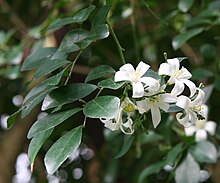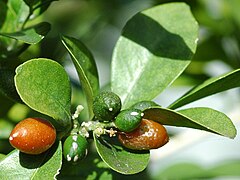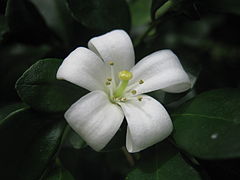Murraya paniculata
| Orange jasmine | |
|---|---|

| |
| Foliage and flowers | |
| Scientific classification | |
| Kingdom: | Plantae |
| Clade: | Tracheophytes |
| Clade: | Angiosperms |
| Clade: | Eudicots |
| Clade: | Rosids |
| Order: | Sapindales |
| Family: | Rutaceae |
| Genus: | Murraya |
| Species: | M. paniculata
|
| Binomial name | |
| Murraya paniculata | |
| Synonyms[2] | |
|
Homotypic Synonyms
Heterotypic Synonyms
| |
Murraya paniculata, commonly known as orange jasmine, orange jessamine, china box or mock orange, is a species of shrub or small tree in the family Rutaceae and is native to South Asia, Southeast Asia and Australia. It has smooth bark, pinnate leaves with up to seven egg-shaped to elliptical leaflets, fragrant white or cream-coloured flowers and oval, orange-red berries containing hairy seeds.
Description
[edit]Murraya paniculata is a tree that typically grows to a height of 7 m (23 ft) but often flowers and forms fruit as a shrub, and has smooth pale to whitish bark. It has pinnate leaves up to 170 mm (6.7 in) long with up to seven egg-shaped to elliptical or rhombus-shaped. The leaflets are glossy green and glabrous, 25–100 mm (0.98–3.94 in) long and 12–50 mm (0.47–1.97 in) wide on a petiolule 2–6 mm (0.079–0.236 in) long.[3][4][5][6]
The flowers are fragrant and are arranged in loose groups, each flower on a pedicel 1–1.5 mm (0.039–0.059 in) long. There are five (sometimes four) sepals about 1 mm (0.039 in) long and five (sometimes four) white or cream-coloured petals 13–18 mm (0.51–0.71 in) long. and the fruit is an oval, glabrous, orange-red berry 12–14 mm (0.47–0.55 in) long containing densely hairy seeds.[3][4][5][6]
Phenology
[edit]Flowering occurs from June to March in Australia, and the fruit ripen between January and October.[4][7] In the northern hemisphere flowering occurs from April to October and fruit ripen from April to February.[8]
Taxonomy
[edit]This species was first described and illustrated by Georg Eberhard Rumphius in the latter half of the 17th century during his time in what was then known as the Dutch East Indies, and published posthumously in 1747.[9] However the first formal description was produced in 1767 by the Swedish botanist Carl Linnaeus who gave it the name Chalcas paniculata and published it in his book Mantissa Plantarum, which is an appendix to the 12th edition of his earlier work Systema Naturae.[10][11] In 1820 the Scottish botanist William Jack changed the name to Murraya paniculata in his book Descriptions of Malayan Plants [Malayan Miscellanies].[12][13]
Distribution and habitat
[edit]Murraya paniculata grows in rainforest, often as an understorey shrub in vine thickets, including behind beaches. It is native to South and Southeast Asia, China and Australasia, while the distribution area extends from Pakistan via India, Sri Lanka and southern China to Taiwan, the Philippines, where it is called kamuníng,[14] the Ryūkyū Islands and the Mariana Islands, to the south via Malaysia and Indonesia to New Guinea and parts of Australia.[4][2] In Australia, it is native to the Kimberley region of Western Australia, northern parts of the Northern Territory, and parts of Queensland.[15][16] The species has been naturalised in other places, sometimes becoming an invasive weed, including on many Pacific islands.[17] In Queensland, it is regarded as different from the cultivated form Murraya paniculata 'Exotica', which is regarded as one of the most invasive plant species in southeast Queensland.[6]
Cultivation
[edit]Murraya paniculata is cultivated as an ornamental tree or hedge because of its hardiness, wide range of soil tolerance (M. paniculata may grow in alkaline, clayey, sandy, acidic and loamy soils), and is suitable for larger hedges. The plant flowers throughout the year and produces small, fragrant flower clusters which attract bees, while the fruits attract small frugivorous birds.[5]
Propagation
[edit]The orange jessamine is sexually propagated by its seeds. The fruits are eaten by birds, which then pass the seeds out in their feces. It may also be asexually propagated by softwood cuttings.[5]
Ecology
[edit]This species is one of the preferred hosts of the citrus pest Diaphorina citri, the citrus psyllid, which is the vector for the Citrus greening disease.[17][18]
Diseases
[edit]M. paniculata is vulnerable to soil nematodes, scales, sooty mold and whiteflies.[5]
Gallery
[edit]-
Flowers and leaves
-
Line drawing showing flowers and fruit
-
Fruits
-
Shrubby formation in cultivation
-
Foliage
-
Flower detail
References
[edit]- ^ "Murraya paniculata". Australian Plant Census. Retrieved 28 July 2020.
- ^ a b "Murraya paniculata (L.) Jack". Plants of the World Online. Royal Botanic Gardens, Kew. 2024. Retrieved 1 January 2024.
- ^ a b F.A.Zich; B.P.M.Hyland; T.Whiffen; R.A.Kerrigan (2020). "Murraya paniculata". Australian Tropical Rainforest Plants Edition 8 (RFK8). Centre for Australian National Biodiversity Research (CANBR), Australian Government. Retrieved 24 June 2021.
- ^ a b c d Mabberley, D.J. (2022). Kodela, P.G. (ed.). "Murraya paniculata". Flora of Australia. Australian Biological Resources Study, Department of Climate Change, Energy, the Environment and Water: Canberra. Retrieved 1 January 2024.
- ^ a b c d e Gilman, Edward F. (October 1999). "Murraya paniculata" (PDF). Institute of Agricultural and Food Sciences, University of Florida. Retrieved 1 January 2024.
- ^ a b c "Murraya paniculata". Weeds of Australia. Identic Pty Ltd. Retrieved 1 January 2024.
- ^ Cooper, Wendy; Cooper, William T. (June 2004). Fruits of the Australian Tropical Rainforest. Clifton Hill, Victoria, Australia: Nokomis Editions. p. 471. ISBN 978-0958174213.
- ^ "Murraya paniculata (L.) Jack". Flora of China (eFloras). Missouri Botanical Garden, St. Louis, MO & Harvard University Herbaria, Cambridge, MA. Retrieved 1 January 2024.
- ^ Rumph, Georg Eberhard (1747). Herbarium amboinense. Amstelaedami. doi:10.5962/bhl.title.569. Retrieved 1 January 2024.
- ^ von Linné, Carl (October 1767). Mantissa Plantarum. Holmiæ: Impensis Direct. Laurentii Salvii. p. 68. Retrieved 29 July 2020.
- ^ "Chalcas paniculata". APNI. Retrieved 29 July 2020.
- ^ "Murraya paniculata". Australian Plant Name Index (APNI). Centre for Australian National Biodiversity Research, Australian Government. Retrieved 1 January 2024.
- ^ Jack, William (1820). Descriptions of Malayan plants No. 2. p. 31. Retrieved 1 January 2024.
- ^ "Kamuning". Stuartxchange. Retrieved 21 November 2021.
- ^ "Murraya paniculata". FloraBase. Western Australian Government Department of Biodiversity, Conservation and Attractions.
- ^ "Murraya paniculata". Northern Territory Government. Retrieved 29 July 2020.
- ^ a b "Murraya paniculata". Pacific Island Ecosystems at Risk (PIER). US Forest Service. Archived from the original on 1 June 2023. Retrieved 29 July 2020.
- ^ Halbert, Susan E.; Manjunath, Keremane L. (2004). "Asian citrus psyllids (Sternorrhyncha: Psyllidae) and greening disease of citrus: a literature review and assessment of risk in Florida". Florida Entomologist. 87 (3): 330–353. doi:10.1653/0015-4040(2004)087[0330:ACPSPA]2.0.CO;2.






